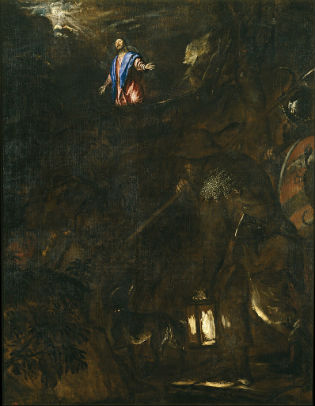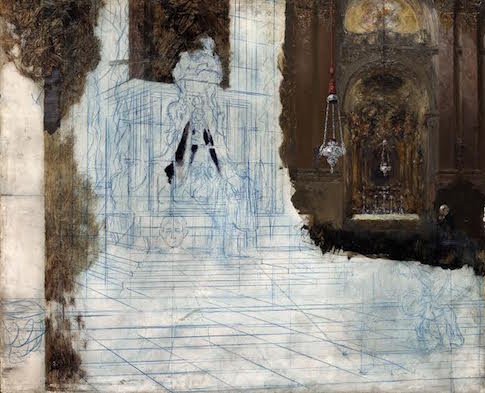Unfinished: Thoughts Left Visible, an exhibition at the Met Breuer, is filled with curiosities.
Take, for instance, the 1775 portrait of a Spanish noblewoman by Anton Raphael Mengs. The subject sits in a chair, resplendent in a silk dress and fur-lined coat. The sumptuous fabric, for which the sitter undoubtedly paid a tidy sum to impress viewers with her status, is not what draws the eye or raises eyebrows today. At some point the sitter’s face was blurred, her distinguishing features reduced to ghostly black shadows cast on opaque flesh. She looks rather like a bank robber wearing pantyhose over her head. The sitter’s lapdog was traced but never painted, leaving a pug-shaped outline of raw wood panel in the middle of the portrait, surrounded on all sides by the rich colors and textures of a finished oil painting. The effect is haunting and, as the placard alongside the painting notes, distinctly modern. The portrait seems to transcend time and genre, as though it had hung in a Spanish villa for centuries before being purchased and altered by Rene Magritte.

Or take the early nineteenth century portrait of Emilia by Sir Thomas Lawrence. The artist, struck by Emilia’s beauty after encountering her at a series of parties, drew her portrait three times on a single canvas "in a fit of folly," depicting her face at different angles and in different expressions. The portrait to the left of center, depicting Emilia with a suggestive smile in three-quarters view, was left as a preparatory sketch. This ephemeral Emilia seems to peek out from behind the finished portrait to her right like a playful spirit who has temporarily vacated the body of her host. It is unclear why Lawrence did not finish the work, although it was displayed in his studio, perhaps as a demonstration of his artistic process.
These two portraits and works like them are the misfit toys of the art world. Before this exhibition, they may have languished in museum archives or the back corners of permanent collections, consigned to purgatory because of real or imagined defects. When the exhibition concludes in September, these misfits likely will be banished back to their islands. Which is kind of a shame, because many of them are instructive, laying bare the artistic process in so many charcoal sketches and untidy brushstrokes; some of them, viewed as cast-offs or ‘fit[s] of folly’ by museum curators and artists alike, are nonetheless suggestive and beautiful. For these reasons, art lovers and aspiring artists may want to pay the exhibition a visit. You won’t get a second shot at some of these pieces.
But Unfinished is not just the bargain bin of the art world. Yes, it has brought together a number of oddball works that reasonably can be called accidents of history: Gustav Klimt’s Portrait of Ria Munk III, for example, incomplete because the artist died while painting it, or Benjamin West’s painting of the Founding Fathers negotiating a peace settlement with Britain, incomplete because the losing side refused to sit for the portrait. These works are interesting in their way. More interesting are the works done in the non-finito style: in other words, works that were left ‘unfinished’ intentionally as a matter of aesthetic, with some details left sketchy or raw.
The non-finito style has always been around, but it took off during the Renaissance as artists looked back at fragments of ancient art and thought to do as the Romans did. There was also a personal element to non-finito art. Renaissance artists were conscious, as Michelangelo is thought to have said, that "every work of art is a self portrait." The creation process must have seemed more fraught viewed this way—as a process whose final products told the audience something about the artist, not just the subject. Some artists chose to leave the question hanging.
The non-finito style imparts a certain mood on a work. When the viewer encounters expanses of raw canvas on otherwise-finished oil paintings, it can feel like reality has been peeled back to reveal a primordial dimension of the art world. The effect is mystical and thought-provoking at best, juvenile and lazy at worst. It has been used to challenge conventions about what constitutes a finished work of art. The exhibition thus documents the history of a provocative idea, and documents it in typical Met style: that is to say, exhaustively. There are over 200 works in the collection. The earliest work was executed in the mid-fifteenth century, while the latest was executed just a few years ago. Rarely do museums offer such sweeping histories, which allow museumgoers to judge how art of the present age stacks up against art of ages past.
A few examples will illustrate how the non-finito style has evolved over time.

Titian’s Agony in the Garden is an early example of the style in painting. Christ is depicted in the background, illuminated by heavenly light. Two Roman soldiers in ahistorical battle dress proceed into the garden in the foreground, their chain mail and cabasset helmets twinkling ominously in the light of a lantern. The painting is dark and muddled apart from the three subjects—although even they have not been given a full polish. Titian has used two sources of light, one from above and one from below, to emphasize important elements of the painting (Christ, the soldiers slouching toward him in the darkness) while obscuring unimportant elements. He has used non-finito to guide the viewer’s attention to what matters.
The nineteenth century was an inflection point in the non-finito style, as it was in all of art. Turner’s work is illustrative of the shift toward greater abstraction, as artists tried to convey fleeting moments, moods, and psychological states. His Sun Setting Over a Lake clings to representation by the most tenuous of threads—a faint horizon line, a dab of yellow paint for the sun with an orange-red corona emanating from it, clouds and waves given texture with rough flecks and splatters of paint—yet it is a sunset without a doubt. And it is engrossing. Turner has conveyed a beautiful scene with remarkable looseness and creativity.
Museumgoers reach the contemporary art on the second floor of the exhibition. What to say about the contemporary art. Here, some of the artists have embraced non-finito as a style worthy for its own sake, often abandoning finish—with its pesky notions of craft, technical skill, beauty—altogether.
Take Voice by Jasper Johns. The frameless painting is a solid wall of gray disturbed by a rectangular wooden block that has been tied to a wire and smeared across the canvas, leaving behind an arc of thin, lighter gray paint. The block and wire contraption are still attached to the work, along with several pieces of silverware suspended limply from the other end of the wire. Just below the block, Johns has painted a single word in capital letters: VOICE. It is not a beautiful work. It is ‘unfinished,’ one supposes, because the implements used to alter the canvas are still attached to it. Or maybe not. The work is an enigma—just the kind of work, so common at contemporary art museums, that visitors pause in front of for a fleeting, bemused second, before walking away.
Johns is not the only offender. There are others: Sol LeWitt, who created a series of small wooden frames representing the 122 ways not to make a cube; Robert Rauschenberg, who painted four canvasses of solid white (the panels are art of infinite variety, he assured the public, because of the shadows cast on them); Roman Opalka, who pledged decades of his life, eight hours per day, to painting hand-crampingly tiny numbers in succession, with the goal of brushing up against infinity. In other words, he chose to do in life what Sisyphus was condemned to do in death.
I will be charitable and say only that these artists have gotten carried away with an idea. But it is an interesting idea, the incomplete, and it has augmented works of art for many generations when paired with imagination, technical skill, and prudence.
